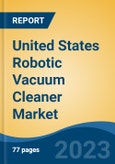Speak directly to the analyst to clarify any post sales queries you may have.
10% Free customizationThis report comes with 10% free customization, enabling you to add data that meets your specific business needs.
As these vacuum cleaners complete tasks faster and without any physical effort, they are becoming more and more popular in the home and business sectors for cleaning floors, windows, pools, and lawns. These robotic vacuum cleaners have reduced the amount of time needed for domestic tasks, which has further increased the market's demand for robotic vacuum cleaner services. Therefore, it is anticipated that rising product demand will fuel the development of the robotic vacuum cleaner market.
The term "robovac" also refers to a robotic vacuum cleaner. A robovac is a particular kind of vacuum cleaner that is set up to clean without any help from a human. All of these robots employ the vacuuming principle to clean, and some of them also have mopping, spinning brushes, and UV sterilization capabilities. Some robovacs are more than simply vacuum cleaners because they are equipped with extra functions such as security cameras, intercom systems, and other different types of functionalities.
When compared to traditional vacuum cleaners, robovacs have the advantage of being quieter. They conserve our time and energy because they can function independently. Once they are turned on, and a cleaning routine is chosen, robot vacuums only need to be positioned in the specific room that needs to be cleaned before going out on their own.
After working for a set amount of time, some varieties of robovacs require recharge, but other types are able to locate their docking station and can recharge on their own. Additionally, compared to traditional vacuum cleaners, robotic vacuum cleaners require a lot less upkeep. Additionally, robovacs take up less room and are smaller in size. All these factors are driving the United States robotic vacuum cleaner market.
Technological Innovations, Including Voice Control Capabilities and Internet Connectivity, Fuels Market Growth
Over the course of the projection period, demand for robotic vacuum cleaners will increase owing to changes in the industry and the incorporation of cutting-edge technology such as Wi-Fi connectivity, AI capabilities, and voice assistance. To satisfy shifting consumer demand, a number of businesses are putting their efforts into developing new products with novel characteristics. Newly created robotic vacuums can recognize voice orders from Alexa and the Google speech assistant and carry them out. Robot makers will have additional prospects as a result of connectivity with other devices via smart home technology or IoT gadgets. This enables the consumers to regulate and personalize the product's actions, improving the cleaning procedure. For instance, Kyvol launched the automatic self-charging robot vacuum cleaner with 150min runtime, a slim, quiet mini-cleaning robot for pet hair from the floors. It is compatible with Google Assistant and Alexa voice remotes. Additionally, based on the choices, the Kyvol APP & remote control may both start/stop/schedule the cleaning.Innovative Offering Fuels Market Growth
Owing to the time and effort they save, consumers across all market sectors are placing a premium on automated devices. As consumers use automated cleaners more frequently, which encourages the use of smart home technology, market growth is projected. However, conventional building techniques and the intelligent home are now both feasible and enticing owing to advancements in electronics and their smooth integration with older technologies. It is projected that the market for robotic vacuum cleaners will develop as a result of the inclusion of air filters in automated machines for consumers who suffer from allergies. Demand for robotic vacuum cleaners is increasing as consumers turn to these devices to lessen their exposure to dust or pet allergens. One of the main socio-economic variables anticipated to drive the growth of the US robotic vacuum cleaner market is the increased number of working women participation.Market Segmentation
United States robotic vacuum cleaner market is segmented into type, end-use, distribution channel, region, and company. Based on type, the market is segmented into floor vacuum cleaners, pool vacuum cleaners, and window vacuum cleaners. Based on end-use, the market is segmented into residential and commercial. Based on distribution channels, the market is segmented into supermarkets/hypermarkets, electronic stores, exclusive stores, online, and others.Market Players
iRobot Corporation, iMartine, Samsung Electronics America, Inc., Fantasia Trading LLC, LG Electronics U.S.A. Inc., SharkNinja Operating LLC, Hometimesrobot, Target Brands, Inc., Kyvol, Inc., Maytronics Ltd. are the major market players in the United States Robotic Vacuum Cleaner Market.Report Scope:
In this report, United States robotic vacuum cleaner market has been segmented into the following categories, in addition to the industry trends, which have also been detailed below:United States Robotic Vacuum Cleaner Market, By Type:
- Floor Vacuum Cleaner
- Pool Vacuum Cleaner
- Window Vacuum Cleaner
United States Robotic Vacuum Cleaner Market, By End-Use:
- Residential
- Commercial
United States Robotic Vacuum Cleaner Market, By Distribution Channel:
- Supermarkets/Hypermarkets
- Electronic Stores
- Exclusive Stores
- Online
- Others
United States Robotic Vacuum Cleaner Market, By Region:
- South
- West
- Mid-West
- North-East
Competitive Landscape
Company Profiles: Detailed analysis of the major companies present in the United States robotic vacuum cleaner market.Available Customizations:
With the given market data, the publisher offers customizations according to a company's specific needs.This product will be delivered within 1-3 business days.
Table of Contents
Companies Mentioned
- iRobot Corporation
- iMartine
- Samsung Electronics America, Inc.
- Fantasia Trading LLC
- LG Electronics U.S.A. Inc.
- SharkNinja Operating LLC
- Hometimesrobot
- Target Brands, Inc.
- Kyvol, Inc.
- Maytronics Ltd.








